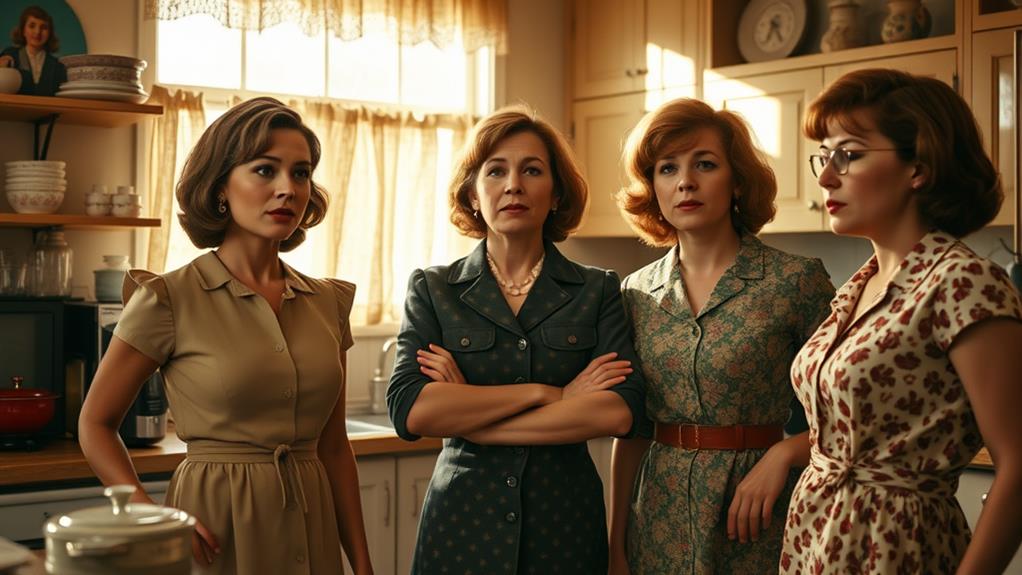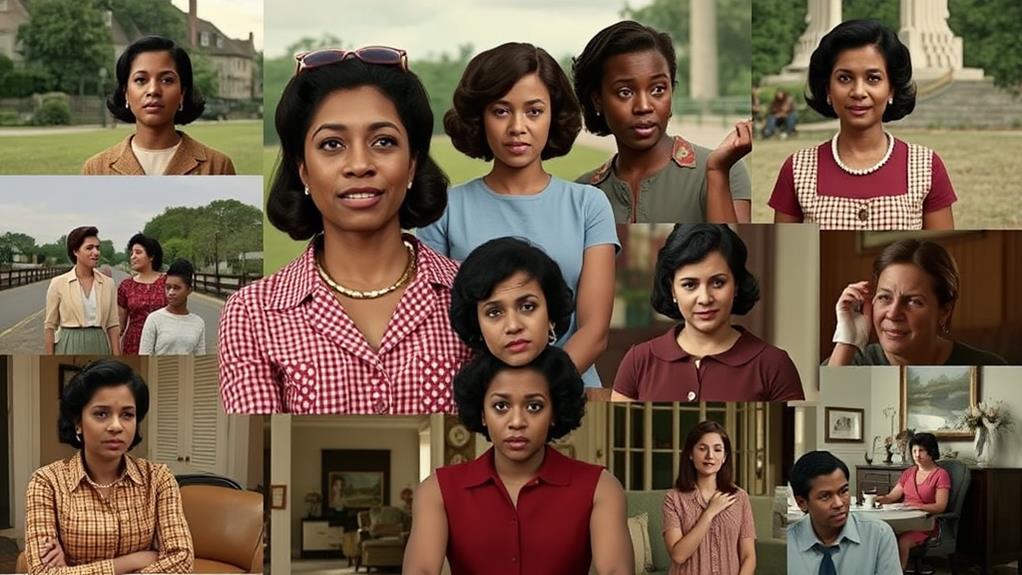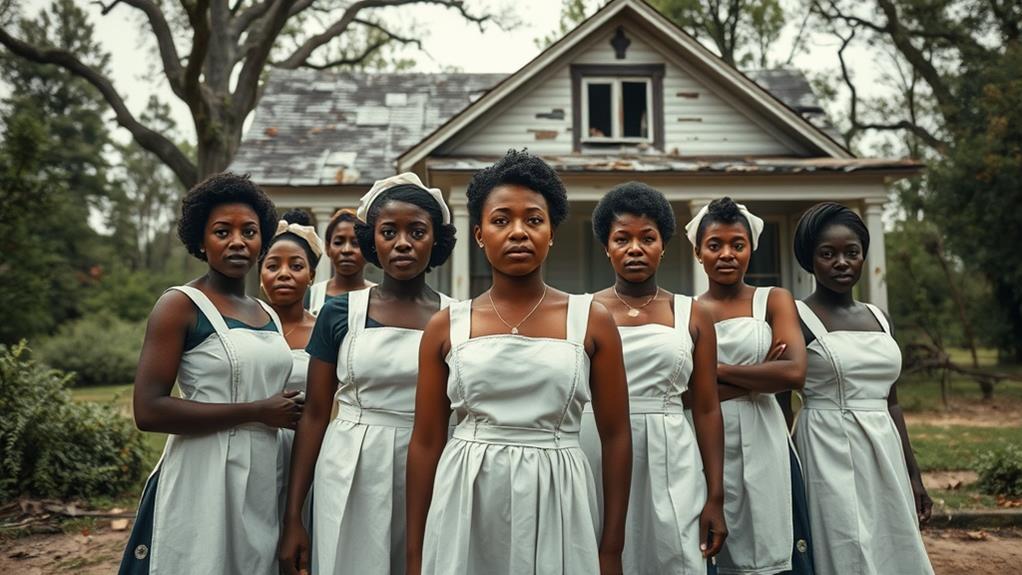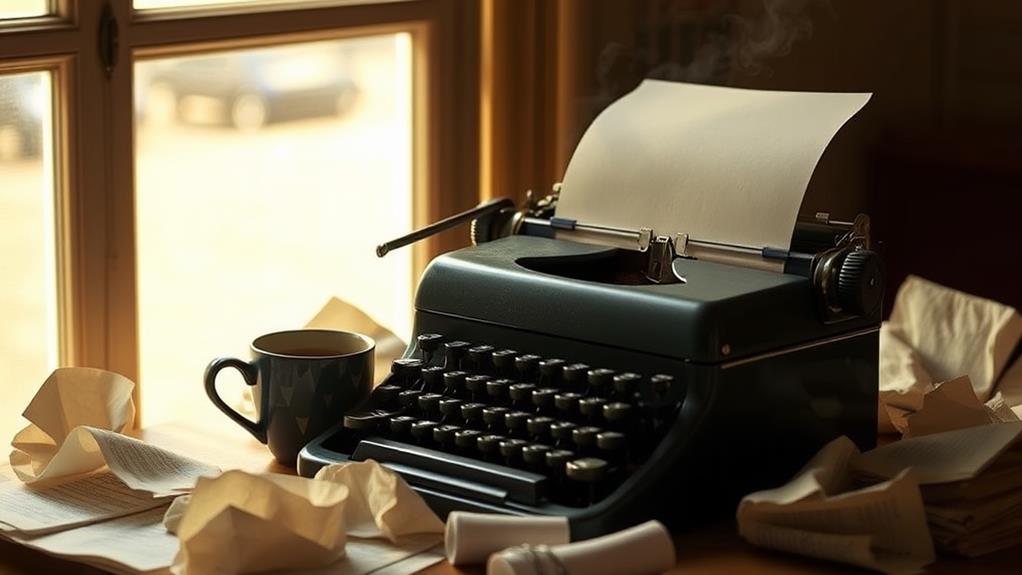In 'The Help,' you explore the brave lives of black maids during the oppressive Jim Crow era in Mississippi. The film highlights their struggles, showcasing Aibileen and Minny's incredible courage against systemic racism. You see Skeeter transform from a sheltered young woman to a fearless advocate for justice through her storytelling. The vibrant visuals and powerful performances by Viola Davis and Octavia Spencer deepen your connection to these characters. This emotional journey, enriched with humor and heart, invites you to understand the broader themes of resilience and resistance. There's so much more to uncover about their stories and impact.
Film Overview
"The Help" offers a poignant glimpse into the lives of black maids in 1960s Mississippi, showcasing their struggles and resilience against a backdrop of racial tension. The film, adapted from Kathryn Stockett's best-selling novel, immerses you in the Jim Crow era, where you witness the complex relationships between black maids and the white women they serve.
Through the eyes of Skeeter, a white woman enthusiastic to tell their stories, you explore the harsh realities these maids face daily. The film highlights disparities in treatment between white families and black domestic workers, acting as a catalyst for conversations about race in America.
Aibileen and Minny, two central characters, embody the courage of countless black maids who navigate a world filled with discrimination and oppression. Their experiences highlight the stark social hierarchy that exists, as they work tirelessly for families while often being treated as less than human.
The film doesn't shy away from the serious social issues at play, yet it balances these themes with humor and warmth, making it both entertaining and thought-provoking.
As you watch, you can't help but feel a deep connection to the struggles of these women, inspiring you to reflect on the importance of empowerment and change in the face of adversity.
Character Analysis
In "The Help," you witness Skeeter's transformation from a sheltered woman to a fierce advocate challenging the status quo.
This journey mirrors the resilience and strength of women facing adversities, as Aibileen and Minny's resilience shines through their struggles, revealing the strength of their bond as they confront harsh realities.
Together, these characters illustrate the complexities of race and privilege in 1960s Mississippi.
Skeeter's Transformation Journey
How does a privileged young woman evolve into a powerful advocate for justice? Skeeter, portrayed by Emma Stone, begins her journey caught between societal expectations and a growing awareness of the injustices faced by black maids in Jackson, Mississippi.
Her transformation kicks off with her desire to write a book that captures the true experiences of Aibileen and Minny, marking a pivotal shift from ambivalence to advocacy.
As Skeeter faces backlash from her peers, particularly Hilly Holbrook, you see her courage to defy social norms. This backlash highlights her commitment to prioritizing justice over acceptance.
Her relationship with Aibileen evolves considerably; what starts as ignorance blossoms into respect and collaboration. This growth showcases Skeeter's deepening understanding of the complexities surrounding race and gender dynamics.
Aibileen and Minny's Resilience
Aibileen and Minny's resilience shines brightly against the backdrop of Jim Crow-era Mississippi, revealing the strength and courage of black maids in a deeply oppressive society. Aibileen Clark, portrayed by Viola Davis, embodies nurturing emotional strength, having raised 17 white children despite the personal sacrifices she endures.
Meanwhile, Minny Jackson, played by Octavia Spencer, demonstrates assertiveness, standing firm against mistreatment and inspiring Aibileen to find her own voice.
Their resilience manifests in several powerful ways:
- Acts of Defiance: Both Aibileen and Minny refuse to accept the racial injustices imposed upon them, often finding subtle ways to challenge their employers.
- Solidarity: Their bond serves as a source of empowerment, with Minny encouraging Aibileen to share her story and advocate for their dignity.
- Personal Growth: Aibileen's journey to confront her fears and embrace her voice illustrates her courage, particularly when she chooses to speak out with Skeeter.
Together, Aibileen and Minny not only survive but also challenge the status quo, showcasing the profound resilience of black maids in their fight for justice and recognition.
Acting Performance

The acting performances in "The Help" stand out as a powerful component of the film, drawing viewers into the emotional landscape of its characters. Viola Davis and Octavia Spencer deliver riveting portrayals of Aibileen and Minny, respectively, earning critical acclaim and Oscar nominations for their roles. Their chemistry is palpable, enhancing the emotional depth of each scene and showcasing the complexities of race relations during the Jim Crow era, much like the exploration of love and societal pressures found in Giovanni's Room.
You'll find individual moments that highlight the acting brilliance of the cast, especially in scenes where vulnerability and strength collide. These performances leave a lasting impact, making you feel deeply for the characters and their struggles.
Jessica Chastain's portrayal of Celia Foote serves as a striking contrast to her role in "Tree of Life," showcasing her versatility and ability to embody diverse characters with authenticity.
Cinematic Elements
Utilizing vibrant visuals and meticulous attention to detail, "The Help" effectively transports you to the late 1950s and early 1960s, immersing you in its historical setting.
Director Tate Taylor masterfully adapts Kathryn Stockett's novel, preserving its key themes and emotional depth while enhancing the film's authenticity. The visual aesthetics reflect the era, illustrating the stark social hierarchy between black and white communities. This portrayal resonates with ongoing discussions about social justice movements and the importance of understanding historical context in contemporary society.
Here are three cinematic elements that stand out:
- Wardrobe and Makeup: The costumes, hair, and makeup meticulously depict class distinctions, showcasing the contrasting lives of black maids and their white employers.
- Historical Context: Integrating TV and radio segments referencing civil rights struggles, the film grounds its narrative in the political climate of the time, adding depth to the characters' experiences.
- Symbolic Elements: The books on Skeeter's shelf symbolize the power of literature as a tool for social commentary and empowerment, reflecting the themes of race and identity.
Through these cinematic choices, "The Help" not only tells a compelling story but also encourages reflection on the complexities of race relations during a pivotal time in American history.
Critical Reception

With its blend of humor and serious themes, "The Help" garnered positive reviews from critics who appreciated its emotional resonance. Critics highlighted the outstanding performances of Viola Davis and Octavia Spencer, praising their portrayals as deeply moving and deserving of Oscar recognition. Their ability to embody the struggles and triumphs of the black maids brought authenticity to the film, making it a poignant experience for viewers.
Similar to the characters in Liesel's resilience, the maids' courage in the face of societal oppression resonates deeply throughout the narrative, showcasing the strength found in adversity.
However, some critics raised concerns about the narrative's potential to promote a "white savior" complex. While they acknowledged this criticism, they also noted that the strong character arcs of the black maids effectively counterbalanced any such implications. This complexity allowed the film to address significant issues surrounding race and social justice without losing sight of its engaging storytelling.
At approximately 2 hours and 10 minutes, the film felt shorter due to its intriguing plot and emotional depth. The overall consensus among critics deemed "The Help" a must-see film, one that successfully entertains while tackling critical societal themes.
This combination of humor, drama, and compelling performances makes it a standout piece in contemporary cinema.
Themes of Courage
Building on the emotional depth explored in the film's critical reception, "The Help" powerfully illustrates themes of courage through its characters. Aibileen and Skeeter exemplify the bravery required to confront societal norms in Jackson, Mississippi, during the Jim Crow era.
As you watch their journey, you'll see how courage manifests in different forms. The narrative not only highlights individual acts of bravery but also mirrors the broader struggles for justice faced by marginalized groups throughout history, akin to the stories found in hidden stories and perspectives that expand our understanding of past events.
Here are three key aspects of courage depicted in the film:
- Personal Transformation: Aibileen evolves from a place of fear to courage. Inspired by Skeeter's determination to give a voice to the voiceless, she decides to share her story, highlighting the power of personal truth.
- Defiance Against Mistreatment: Minny showcases another facet of courage through her assertiveness. Her refusal to accept mistreatment demonstrates resilience, reminding you that standing up for oneself is crucial in the face of adversity.
- Collective Storytelling: The act of sharing experiences becomes a form of resistance. By coming together, these women not only challenge oppressive systems but also pave the way for social change, reinforcing the message that courage is essential in the fight for justice.
If you were to write a book about these themes, you'd find plenty of inspiration here.
Social Context and Injustices

In "The Help," you see the harsh realities of life under the Jim Crow Laws, where racial segregation and discrimination are woven into everyday existence.
This period in American history reflects systemic racism and the historical legacies that continue to affect Black lives today, as highlighted in Ta-Nehisi Coates' work on systemic racism.
The film captures how these injustices impacted not just the African American community but also the white women who began to question their roles in this oppressive system.
As you explore these themes, you can't help but recognize the crucial role women played in activism during this turbulent time.
Jim Crow Laws Impact
Jim Crow laws systematically dismantled the lives of African Americans in the South, enforcing a brutal regime of racial segregation that permeated every facet of society.
These laws created a world where black characters faced insurmountable barriers while white families enjoyed privileges that were often taken for granted. The consequences were profound and pervasive.
- Education: Schools for black children were underfunded and overcrowded, leading to a severe lack of resources compared to those available to white students.
- Employment: Job opportunities for African Americans were limited to menial positions, while white families had access to a broader range of careers, often with better pay and benefits.
- Voting Rights: Discriminatory practices, like literacy tests and poll taxes, disenfranchised black citizens, effectively silencing their voices in political matters.
The legacy of Jim Crow laws, marked by racial violence and intimidation, created an environment of fear and oppression.
Today, the effects of these laws linger, shaping disparities in education, criminal justice, and economic opportunities for African Americans, revealing how deeply entrenched these injustices remain in society.
Racial Segregation and Discrimination
While racial segregation and discrimination were deeply embedded in the fabric of Southern society, their impact extended far beyond mere legal restrictions. The Jim Crow Laws enforced a system that institutionalized inequality, affecting every aspect of life for African Americans. Public facilities, schools, and neighborhoods remained divided, with the "separate but equal" doctrine merely serving as a façade for the vast disparities in resources.
You'd notice that black children attended poorly funded schools, lacking the essential materials and opportunities their white counterparts enjoyed.
This systemic discrimination didn't stop at education. Voting rights restrictions, like literacy tests and poll taxes, aimed to disenfranchise black voters, ensuring that white supremacy prevailed in political power.
Fear was a constant companion, as acts of violence, including lynching, were used to maintain racial hierarchy and silence dissent.
The pervasive climate of racial segregation created an environment where African Americans were denied basic rights and dignity. You could feel the weight of injustice pressing down on individuals, stifling their aspirations and dreams.
The scars of discrimination ran deep, shaping not only personal experiences but the very essence of the community's struggle for equality.
Women's Roles in Activism
Women like Aibileen and Minny courageously stepped into the spotlight during the Civil Rights Movement, sharing their powerful stories and challenging the injustices they faced as black maids in Jackson, Mississippi. Their activism highlighted how women, often silenced by societal norms, found their voices to confront racial and gender discrimination.
In "The Help," you see how these women navigate the oppressive Jim Crow laws while advocating for their rights and those of others.
Here are three key ways women like Aibileen and Minny contributed to activism:
- Storytelling: By sharing their experiences, they humanized the struggles of black maids, creating empathy and raising awareness.
- Collective Action: The support networks they formed empowered women to challenge racial norms together, fostering courage and solidarity.
- Defying Expectations: Characters like Skeeter, alongside Aibileen and Minny, broke societal barriers, demonstrating that activism can come from unexpected places.
Through their bravery and resilience, these women not only fought for their dignity but also laid the groundwork for future generations in the ongoing struggle for equality.
Role of Women in Activism
The impact of women in activism has often been underestimated, yet their contributions have been indispensable in challenging systemic injustices. In "The Help," characters like Aibileen and Minny embody the resilience and strength of black women who faced immense oppression while advocating for change in their communities.
These women in Jackson, Mississippi, exemplify how grassroots efforts can arise from shared experiences and solidarity. Similar to the struggles of the Nolans in Brooklyn, the challenges faced by Aibileen and Minny highlight the universal themes of poverty and resilience amidst adversity, showcasing the strength of immigrant and marginalized communities in their fight for dignity and respect the struggles of immigrant communities.
Aibileen, as a caregiver, uses her position to nurture not only the children she cares for but also her community, voicing the struggles of black maids. Minny, with her fierce spirit, confronts the injustices she faces daily, illustrating the power of courage in activism. Together, they inspire their fellow maids to rise against their fears and speak out against the racial injustices they endure.
Historically, women like them leveraged their roles within the home to challenge societal norms, emphasizing the intersection of gender and race in activism. The legacy of their efforts during the Jim Crow era continues to resonate, reminding us that inclusive approaches are essential in the ongoing fight for equality.
Their stories remind us of the significant role women play in activism today.
The Power of Storytelling

In "The Help," storytelling becomes a powerful act of resistance, allowing characters like Aibileen and Minny to share their truths and challenge societal norms.
This narrative approach resonates with the themes found in works like the triumph of the human spirit from Louis Zamperini's "Unbroken," where personal accounts highlight resilience against adversity.
You'll see how personal narratives not only empower individuals but also raise awareness about injustices that often go unnoticed.
This film shows that when voices unite through storytelling, they can inspire change and foster empathy across cultural divides.
Storytelling as Resistance
While many forms of resistance exist, storytelling emerges as a particularly powerful tool for challenging systemic oppression, as seen in 'The Help.' By allowing characters like Aibileen and Minny to share their personal experiences, the narrative not only sheds light on the harsh realities of racism but also empowers them to reclaim their voices.
Skeeter's decision to document their lives symbolizes the transformative power of storytelling in fostering empathy and understanding.
Here are three key aspects of storytelling as resistance found in 'The Help':
- Personal Catharsis: Aibileen and Minny use storytelling to process their traumas, allowing them to confront their pain and find healing.
- Challenging Dominant Narratives: By sharing their truths, the maids counter the prevailing racist stereotypes, shifting perceptions among their white counterparts.
- Catalyst for Social Change: Skeeter's book becomes a vehicle for collective resistance, inspiring others in the community to stand against societal norms.
Through these narratives, 'The Help' illustrates how storytelling serves as a powerful method of empowerment, enabling marginalized voices to challenge injustices and drive social change.
Personal Narratives Empowering Change
Through the act of sharing their personal stories, characters in "The Help" transform their experiences into powerful narratives that drive change. Skeeter's interviews with the black maids serve as a vital platform for empowerment, allowing their voices to be heard in a society that often silences them. Aibileen's willingness to contribute her narrative symbolizes a courageous stand against systemic racism, demonstrating how personal narratives can challenge societal norms.
As the maids unite to share their experiences, they foster a sense of community and resilience, even amid significant risks. Their collective storytelling not only sheds light on their harsh realities but also becomes a form of resistance against the oppressive social hierarchy of Jim Crow-era Mississippi.
By revealing their struggles, the maids educate Skeeter and her readers, igniting a dialogue about race relations and social justice.
Ultimately, "The Help" highlights the transformative power of personal narratives, showing how sharing one's story can influence public perception and inspire change. Through these narratives, the characters empower themselves and others, illustrating that courage in storytelling can pave the way for a more just society.
Impact on Social Awareness
The personal narratives shared in "The Help" not only empower the characters but also greatly impact social awareness. By giving voice to the experiences of black maids during the Jim Crow era, the film uses storytelling as a tool for empowerment and resistance against systemic racism. You see how Skeeter's decision to document these stories fosters empathy and understanding among viewers, pushing them to confront uncomfortable truths.
Here are three key impacts on social awareness:
- Amplification of Marginalized Voices: The maids' stories highlight the often-overlooked experiences within society, encouraging audiences to listen and learn.
- Encouragement of Dialogue: By showcasing the emotional toll of racism, "The Help" invites discussions on race relations and social hierarchies, fostering a deeper understanding of these issues.
- Call to Action: The collective storytelling of characters like Aibileen and Minny urges viewers to recognize and challenge injustices in their own communities, promoting empowerment through awareness.
Through its powerful narratives, "The Help" becomes a catalyst for change, inspiring you and others to reflect on societal norms and take action against discrimination.
Lasting Impact and Legacy
"The Help" has left a significant mark on cultural discussions surrounding race and social justice. By bringing national attention to the struggles of black maids during the Jim Crow era, the film has prompted crucial conversations about race relations that resonate even today. Its characters exemplify courage and resilience, inspiring you to reflect on your own acts of bravery in the fight against inequality.
Similar to the experiences of Bigger Thomas in Richard Wright's "Native Son," the film highlights the dehumanizing effects of systemic oppression and the complexities of power dynamics in society, ultimately calling for a deeper examination of these issues systemic racism's impact.
While the film has received accolades for highlighting the strength of black women, it also sparked critiques regarding its white savior narrative. This duality has led to deeper discussions about representation in media, urging creators to approach storytelling with more nuance and authenticity.
The success of Kathryn Stockett's novel continues to fuel these conversations, making it a significant text in discussions about racism and empowerment.
Today, "The Help" remains culturally relevant, often referenced in educational and activist circles. It serves as a touchstone for exploring themes of courage, resistance, and the power of storytelling in addressing historical injustices.
As you engage with its legacy, consider how the film's impact shapes your understanding of race and social justice today.
Conclusion
To sum up, "The Help" not only entertains but also sheds light on the harsh realities of racial injustice. It's striking to note that, during the 1960s, nearly 60% of African American women were employed as domestic workers, reflecting systemic inequality. This film empowers viewers to recognize the strength in storytelling and the importance of women's voices in activism. By uncovering these stories, we can honor the past and inspire future generations to challenge injustice and drive change.



